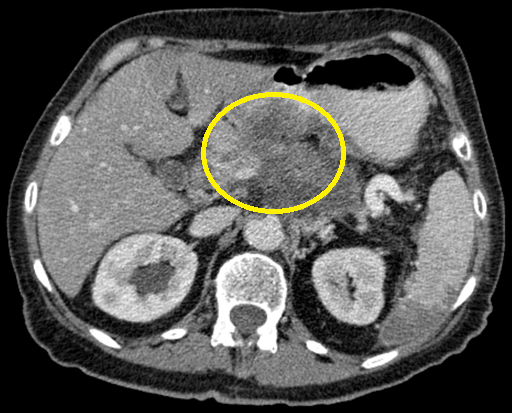Pancreatic cancer CT: Difference between revisions
Jump to navigation
Jump to search
| Line 8: | Line 8: | ||
==CT== | ==CT== | ||
===Pancreatic Adenocarcinoma=== | ===Pancreatic Adenocarcinoma=== | ||
*Findings on CT scan that may be suggestive of Pancreatic cancer include: <ref name="pmid19129613">{{cite journal| author=Horwhat JD, Gerke H, Acosta RD, Pavey DA, Jowell PS| title=Focal or diffuse "fullness" of the pancreas on CT. Usually benign, but EUS plus/minus FNA is warranted to identify malignancy. | journal=JOP | year= 2009 | volume= 10 | issue= 1 | pages= 37-42 | pmid=19129613 | doi= | pmc= | url=https://www.ncbi.nlm.nih.gov/entrez/eutils/elink.fcgi?dbfrom=pubmed&tool=sumsearch.org/cite&retmode=ref&cmd=prlinks&id=19129613 }} </ref> <ref name="pmid2827228">{{cite journal| author=Freeny PC, Marks WM, Ryan JA, Traverso LW| title=Pancreatic ductal adenocarcinoma: diagnosis and staging with dynamic CT. | journal=Radiology | year= 1988 | volume= 166 | issue= 1 Pt 1 | pages= 125-33 | pmid=2827228 | doi=10.1148/radiology.166.1.2827228 | pmc= | url=https://www.ncbi.nlm.nih.gov/entrez/eutils/elink.fcgi?dbfrom=pubmed&tool=sumsearch.org/cite&retmode=ref&cmd=prlinks&id=2827228 }} </ref><ref name="pmid6867347">{{cite journal| author=Karasawa E, Goldberg HI, Moss AA, Federle MP, London SS| title=CT pancreatogram in carcinoma of the pancreas and chronic pancreatitis. | journal=Radiology | year= 1983 | volume= 148 | issue= 2 | pages= 489-93 | pmid=6867347 | doi=10.1148/radiology.148.2.6867347 | pmc= | url=https://www.ncbi.nlm.nih.gov/entrez/eutils/elink.fcgi?dbfrom=pubmed&tool=sumsearch.org/cite&retmode=ref&cmd=prlinks&id=6867347 }} </ref><ref name="pmid9124153">{{cite journal| author=Raptopoulos V, Steer ML, Sheiman RG, Vrachliotis TG, Gougoutas CA, Movson JS| title=The use of helical CT and CT angiography to predict vascular involvement from pancreatic cancer: correlation with findings at surgery. | journal=AJR Am J Roentgenol | year= 1997 | volume= 168 | issue= 4 | pages= 971-7 | pmid=9124153 | doi=10.2214/ajr.168.4.9124153 | pmc= | url=https://www.ncbi.nlm.nih.gov/entrez/eutils/elink.fcgi?dbfrom=pubmed&tool=sumsearch.org/cite&retmode=ref&cmd=prlinks&id=9124153 }} </ref><ref name="pmid22699206">{{cite journal| author=Asagi A, Ohta K, Nasu J, Tanada M, Nadano S, Nishimura R et al.| title=Utility of contrast-enhanced FDG-PET/CT in the clinical management of pancreatic cancer: impact on diagnosis, staging, evaluation of treatment response, and detection of recurrence. | journal=Pancreas | year= 2013 | volume= 42 | issue= 1 | pages= 11-9 | pmid=22699206 | doi=10.1097/MPA.0b013e3182550d77 | pmc= | url=https://www.ncbi.nlm.nih.gov/entrez/eutils/elink.fcgi?dbfrom=pubmed&tool=sumsearch.org/cite&retmode=ref&cmd=prlinks&id=22699206 }} </ref> | |||
CT | **Morphological changes of the gland with abnormalities of CT attenuation values, | ||
**Destruction of the peripancreatic fat and loss of the sharp margins with surrounding structures | |||
**Involvement of the regional lymph nodes and adjacent vasculature | |||
**Pancreatic ductal dilatation | |||
**Pancreatic atrophy | |||
**Obstruction of the common bile duct (CBD) | |||
[[Image:CT_Pancreatic_cancer.png|thumb|350px|center|By Hellerhoff (Own work) [CC BY-SA 3.0 (https://creativecommons.org/licenses/by-sa/3.0)], via Wikimedia Commons]] | [[Image:CT_Pancreatic_cancer.png|thumb|350px|center|By Hellerhoff (Own work) [CC BY-SA 3.0 (https://creativecommons.org/licenses/by-sa/3.0)], via Wikimedia Commons]] | ||
Revision as of 21:56, 15 November 2017
|
Pancreatic cancer Microchapters |
|
Diagnosis |
|---|
|
Treatment |
|
Case Studies |
|
Pancreatic cancer CT On the Web |
|
American Roentgen Ray Society Images of Pancreatic cancer CT |
Editor-In-Chief: C. Michael Gibson, M.S., M.D. [1]; Associate Editor-In-Chief: Cafer Zorkun, M.D., Ph.D. [2];Parminder Dhingra, M.D. [3];Faizan Sheraz, M.D. [4]
Overview
On abdominal CT scan, pancreatic cancer appears as a poorly defined mass with surrounding desmoplastic reaction.
CT
Pancreatic Adenocarcinoma
- Findings on CT scan that may be suggestive of Pancreatic cancer include: [1] [2][3][4][5]
- Morphological changes of the gland with abnormalities of CT attenuation values,
- Destruction of the peripancreatic fat and loss of the sharp margins with surrounding structures
- Involvement of the regional lymph nodes and adjacent vasculature
- Pancreatic ductal dilatation
- Pancreatic atrophy
- Obstruction of the common bile duct (CBD)

References
- ↑ Horwhat JD, Gerke H, Acosta RD, Pavey DA, Jowell PS (2009). "Focal or diffuse "fullness" of the pancreas on CT. Usually benign, but EUS plus/minus FNA is warranted to identify malignancy". JOP. 10 (1): 37–42. PMID 19129613.
- ↑ Freeny PC, Marks WM, Ryan JA, Traverso LW (1988). "Pancreatic ductal adenocarcinoma: diagnosis and staging with dynamic CT". Radiology. 166 (1 Pt 1): 125–33. doi:10.1148/radiology.166.1.2827228. PMID 2827228.
- ↑ Karasawa E, Goldberg HI, Moss AA, Federle MP, London SS (1983). "CT pancreatogram in carcinoma of the pancreas and chronic pancreatitis". Radiology. 148 (2): 489–93. doi:10.1148/radiology.148.2.6867347. PMID 6867347.
- ↑ Raptopoulos V, Steer ML, Sheiman RG, Vrachliotis TG, Gougoutas CA, Movson JS (1997). "The use of helical CT and CT angiography to predict vascular involvement from pancreatic cancer: correlation with findings at surgery". AJR Am J Roentgenol. 168 (4): 971–7. doi:10.2214/ajr.168.4.9124153. PMID 9124153.
- ↑ Asagi A, Ohta K, Nasu J, Tanada M, Nadano S, Nishimura R; et al. (2013). "Utility of contrast-enhanced FDG-PET/CT in the clinical management of pancreatic cancer: impact on diagnosis, staging, evaluation of treatment response, and detection of recurrence". Pancreas. 42 (1): 11–9. doi:10.1097/MPA.0b013e3182550d77. PMID 22699206.